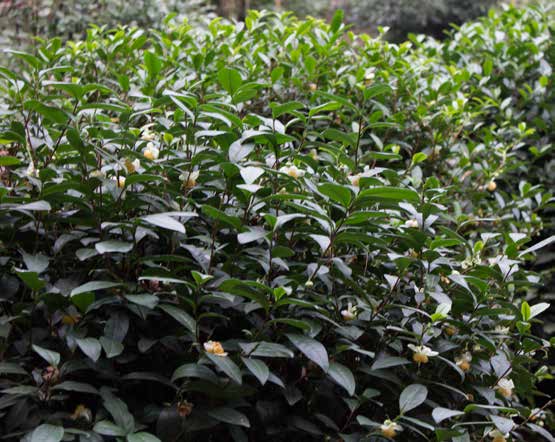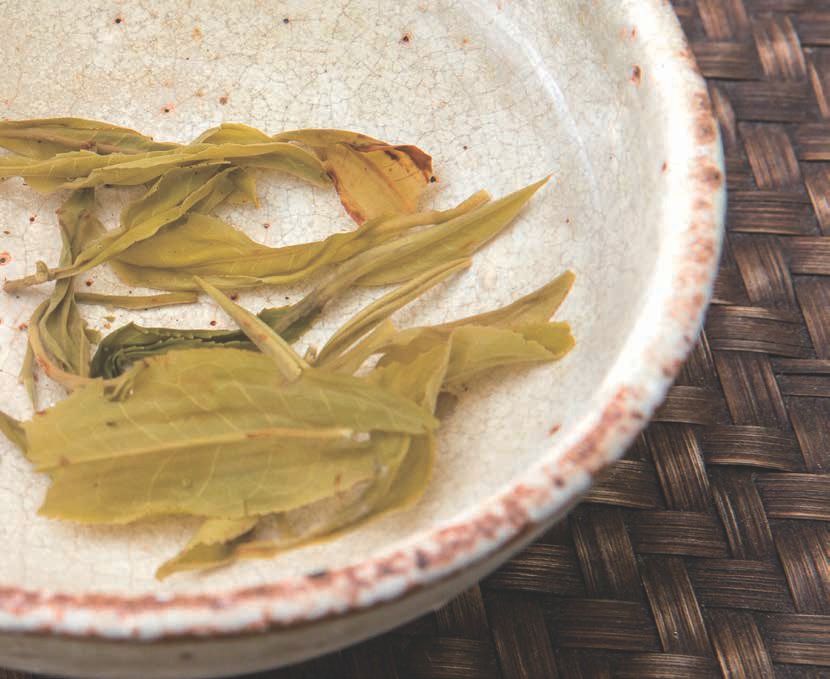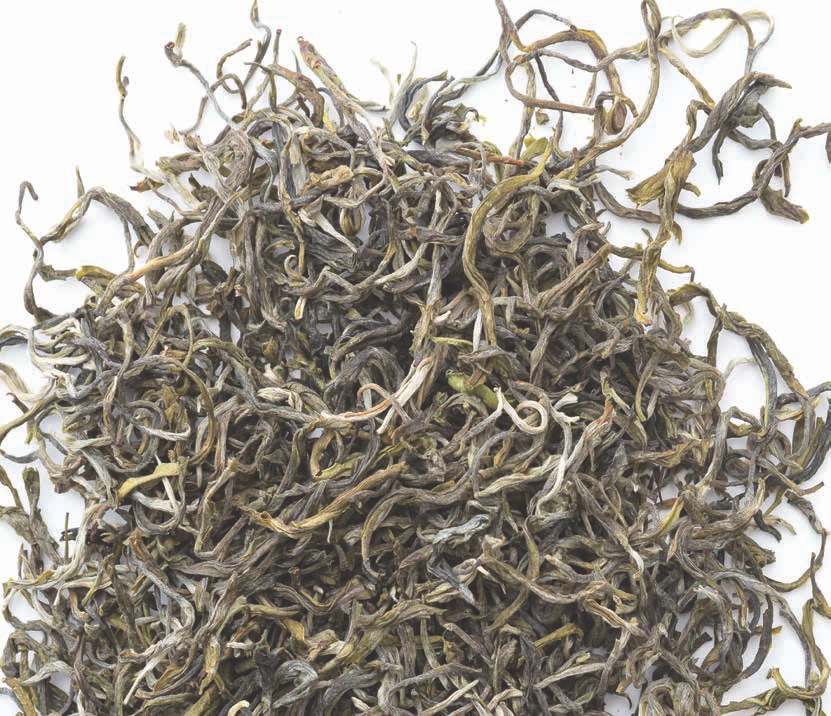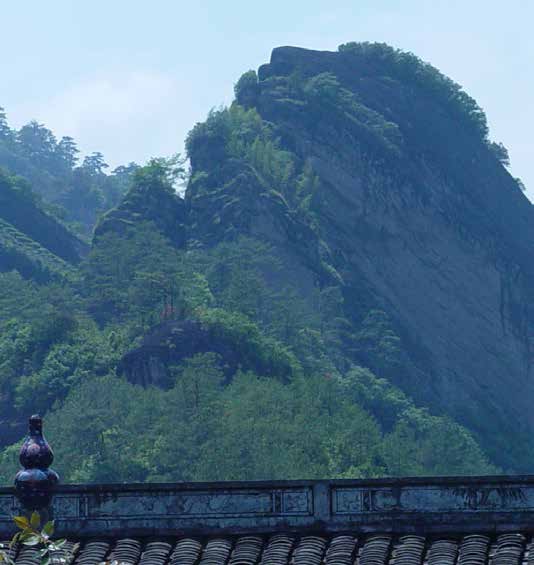
 |
|

Green tea is one of the purest kinds of tea, and the least processed. It is often a Chajin's first love - the Tea whose aroma carries us to the places where names like "Temple Mist" and "Dragonwell" make perfect sense. Green teas often taste of such vistas as well, recalling clear stream water singing over stones, forest pines, or sometimes the lightest fragrance of a flower caught on the breeze, though not for long enough to identify... There is a magic in these light aromas, and in the uplifting Qi that often sweeps us up off our cushions. Sometimes it is nice to return to our roots, remembering Nature through perfect fragrance. The freshness of green tea also reminds us of the weather, though it is often great when it is aged, too. Let us all celebrate the poetry of tea fragrances this month, as we stray into old dreams of bright leaves floating around a cracked bowl...
The official beginning of spring in ancient China was the day the emperor sipped the first cup of the first flush of green tea, heralding the arrival of the Lunar New Year as well. Preserving the freshness is the key to all green tea processing. This is done by intruding but minimally. The two most important aspects of green tea production are reducing the withering/oxidation as much as possible and shaping the leaves in a way that suits their nature, color and fragrance.
Green tea is lighter than other teas because the processing is minimal. Plant cells have thick walls, and so without cellular breakdown, the tea does not release as much of its essence. It is impossible for tea to be processed without some oxidation; it begins oxidizing the moment it is picked. Also, the water content of fresh leaves is too high to process. If you fired or shaped such tea it would break, being brittle from the water in the leaves. During the trip from the field (or forest if it's Living Tea) to the processing area, the tea naturally withers, losing moisture and becoming soft enough for processing. Ideally, green tea should be processed quickly, on the same day as plucking.
Traditionally, the best green teas were made from buds only. It takes tens of thousands of buds to make one jin (600 grams) of such tea. The buds can also be processed with less oxidation, retaining more of the essence of the fresh leaf. They are also young and Yang in energy, which contributes to the magic of green tea. Over time, a greater demand for green tea has led to many kinds of green teas that are combinations of buds and leaves, or even just leaves. In many instances, such blends or leafy green teas are inferior quality. But as green tea has gained popularity, more regions are producing it and using many different varietals that weren't traditionally used in green tea production. Sometimes, depending on the varietal and terroir, a leaf/bud blend can actually be better than just buds, adding depth and Qi to a particular green tea. Our tea of the month is a good example of this, as we will soon see...
Though we love green tea, we don't often get the chance to share it here in Global Tea Hut, because it is a genre of tea that has less Living and/or organic representatives. As you know, we only share Living Tea or organic plantation tea (or the middle ground we discussed in the November, 2014 issue, which we call "ecological garden tea"). In China, green tea accounts for more than 70% of all tea produced. It is the drink of the masses - often tossed in glasses at restaurants to be slurped with noodles, in tea bags or bottled teas, etc. Just about every Chinese person drinks tea daily, and since almost three-fourths of it is green tea, this has created a very, very large demand. As a result, most green tea in China is mass-produced on large plantations, and in a way that is destructive to the environment. Though rows of "pretty" green tea bushes rolling over the hills may look nice in a photo (we don't think so), it is actually the result of mass deforestation and a loss of ecology to millions of species. Monoculture just doesn't work, and it isn't a sustainable way to support agriculture for the population we have on the Earth now, let alone into the future. When you add to that the agro-chemicals that harm the land, eventually ruining it fallow, and the run-off which harms environs in the valleys around the tea mountains - all of that puts green tea production/producers up amongst the worst agriculture for the environment.
While there are plenty of inspiring Living Teas and/or organic plantations in all the seven genres of tea, we find that there are much less great examples of such teas in the genre of green tea. But we promise to find them and share them in the spring and summer, when such tea is the most pleasing to drink (for most climates, anyway). As we do so, and as this global community grows, we can use our voice to support the growing trends of sustainable, healthy teas of all genres!
There are many ways of processing green tea, based on local varietals of leaf and terroir - especially if we include the mastery of tea production handed down generation to generation within the umbrella of what "terroir" is. Remember, "terroir" is a French word that is generally used in discussions of wine, but it is so applicable to tea as well that most tea lovers have adopted it into their discussions of the Leaf. Terroir denotes the special characteristics of a place, found in its geology, geography, climate and even cultural heritage which interact with a cultivated plant species to create unique expressions. Terroir is the soil and weather of a particular region; the geography and culture of the people and their relationship to the plant, and even the microorganisms and their interaction with the plants. Every place has a unique soil composition, pH, minerals and climate - all of which create a distinctive tea. When we talk about a tea's terroir, we are speaking to the unique environment that created it, one which couldn't be reproduced elsewhere. Even if you took a grafting of a tree and cloned it elsewhere, it wouldn't be the same since the sun would be weaker or stronger, the soil composition different, etc.

Whether or not the green tea is all buds, bud-leaf sets or just leaves will also determine how it is processed. The basic kinds of traditional hand-processed green tea are: pan-firing, basket firing, oven baking and steaming. With the introduction of modern machinery, however, many of these steps have changed. Pan-firing to arrest oxidation and de-enzyme the tea, for example, is often done in large, heated tumblers nowadays. Our tea of the month was pan-fired. Steaming tea is only done in Japan, which is how they arrest oxidation/de-enzyme their tea. The result is the dark green color of Japanese teas, as well as the bright green liquor and distinct flavors such teas offer. (Some of you have been around this Hut long enough to remember the gorgeous Japanese Sencha Steve Kokker donated some years ago!)
Most Chinese green tea will spend some time in a tumbler nowadays, as farmers are dealing with a volume that exceeds what they can handle. This arrests the oxidation and helps kill bacteria/mold on the fresh tea, often before a partial pan-firing, basket firing or oven baking. After this step, the tea is shaped/rolled, especially if it contains leaf-bud sets or just leaves. Sometimes, the firing/baking and rolling/shaping will be repeated until the tea is dried, and the desired shape created.
There is great skill in processing green tea, since it is so simple. Sometimes we assume that mastery is in the more refined of the arts, but it is often the simplest things that take the greatest effort and skill. Great chefs don't need to cook with tons of spices all the time; they can also bring out the natural flavors of ordinary ingredients in unexpected ways. We once had a vegetarian chef stay at the center and he cooked up the carrots we eat regularly, only they tasted somehow more "carroty" than usual! They were delicious. And it was carrots, oil and salt - nothing else! Similarly, green tea at its finest is an expression of simple tea leaves as they are in Nature: bitter, astringent with a transforming sweetness that lingers on the palate. And the simplicity shines when a green tea is good, like ours this month!

In the Chinese lunar calendar, Qing Ming (清明) is an important holiday. It usually falls on April 5th each year, though it waivers like the moon. The highest quality spring green teas are often Pre-Qing Ming (明前茶). The leaves that sprout just before this time are more tender and sweet, often with less bitterness and astringency. For that reason, they are valued in the market as the highest grade of green tea. The next highest grade is that which is produced a couple weeks after Qing Ming, which is called "Pre-rains tea (雨前茶)". The buds from this flush are also often tender, but not as much so as Pre-Qing Ming teas.
With climate change, agrochemicals and other human influences, much of the meaning and premium of "Qing Ming" is lost nowadays. Even leaving aside the many fakes, different regions have very different terroirs, which means different qualities of tea. Also, what is valued by the mainstream is often based on different standards than the tea lover has. Sometimes we value the energy (Qi) of the tea more than the flavors, especially when viewing tea as medicine. And all of this does not take into account the changes that have started due to climactic fluctuations and agro-chemicals, especially chemical fertilizers, which change the time and manner that tea bushes flush with buds.
Temple Mist (寺 廟 薄 霧) is a beautiful and very special green tea from the highest peak of Yunnan, Wu Liang Mountain. Some of you may remember that one of our 2013 Light Meets Life sheng puerh cakes was from there. Wu Liang Mountain is really a chain of mountains and hills in Puerh Prefecture. Since tea from there is not as popular as other regions of Yunnan, much of the area still remains pristine and pure. There is a lot of great puerh, red (Dian Hong) and green tea produced there every year.

Our gorgeous Temple Mist is certified organic (JN Organic Certification). It is unique because it is produced from large-leaf varietal trees (Camellia sinensis var. Assamica). We find that the big-leaf trees, which may have some age, lend the tea a bit of Qi and depth that is often missing from most commercial green teas these days. It is also much more 'patient', which means you can steep it many, many times. Temple Mist is also processed beautifully. Big-leaf tea leaves are more bitter and astringent than the small-leaf varietals usually used in green tea production. That, along with processing, is why most young sheng puerh is bitter and astringent. But Temple Mist transforms beautifully, starting out with bitterness and then immediately cascading through the five flavors of tea (bitter, astringent, gan, sour and sweet) to leave a long lasting and coating sweetness in the mouth. This means it was processed well. Tea lovers should grow to love the bitterness in Tea. After all, Tea is a bitter herb!
This batch of tea is known as "Mao Feng, 毛峰". It is a high grade of green tea picked when it's just a few days old. Mao Feng is picked as one-leaf-one-bud sets, which are all covered with downy hairs. This makes the flavors milder with floral and fruity notes. The lasting sweetness reminds you of spring water from the mountains, bringing lasting satisfaction. Though it is an autumn tea, Temple Mist is still fresh and strong. Because of Yunnan's tropical climate, green tea has more than one season and they aren't as different in green tea terms as they are in puerh, though they do vary. The autumn version tends to be milder and calmer, with a bit more balance of Yin in the small Yang bud sets. Spring tea, on the other hand is very Yang. We like the balance. Anyway, we received this tea before the spring harvest, and are very grateful to have it and share it with all of you!

We named this tea Temple Mist because of its transporting and uplifting nature. And the Qi wavers and pulses, as a temple would seem from the mountain path below - as you hike up the old stairs, you catch glimpses of it through the morning mists. You truly need poetry to describe the sensations of drinking a fine green tea! We know that you will enjoy this herald of spring, which hopefully accompanies a dramatic shift in the weather where you are. For most of us, it is a change towards warmer, longer days - days that are more inspired with some gloriously green leaves unfurling in their warm waters...

A day left behind, Forgotten on the mountains And the inner temples there. Winding stone stairs Appear and disappear with the mists Like all dharmas, And Shariputra too... Remembered ages later, In these bowls of jade leaves. There's no need to go looking. He isn't at home... The master's gone tea-picking - Cloud-hidden Whereabouts unknown.
Since this is a large-leaf varietal green tea, you will not find more gorgeous tea leaves on this planet! And that means that leaves in a bowl is the penultimate brewing technique for this tea. Even if you save some of this delicious tea to be brewed in a pot later, please be sure to put a few leaves in a bowl and add some steaming water; we implore you. You will be rewarded by one of the greatest joys a tea lover can know: watching gloriously jade green leaves open before your eyes, sipping radiant and true Nature. The dancing green leaves will bring you endless enjoyment! Of course, all tea is beautiful, opening up before our eyes in a bowl, but this is as good as it gets visually. The fresh, floral aromas are very nice, too, especially wafting up from a bowl held at heart level!
You may want to try using slightly cooled water for this brew. Fine green tea like this can withstand very hot water, as we have discussed often in these pages, but this tea is nice with cooler water. You can bring the water up to Fish Eye and let it cool off the fire for a minute or so before spinning the leaves around the bowl. You can use this cooler water for the first three or four bowls and then slowly increase the temperature over the next few steepings, noticing how the heat gets deeper into the leaves. At that time, the bitterness will transform into mineral flavors with the lingering sweet aftertaste of good spring water. Such bowls are beyond words!